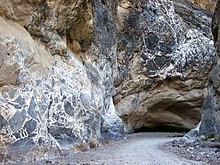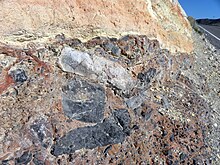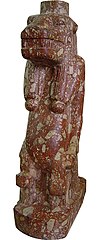



Breccia (/ˈbrɛtʃiə, ˈbrɛʃ-/) is a rock composed of large angular broken fragments of minerals or rocks cemented together by a fine-grained matrix.
The word has its origins in the Italian language, in which it means "rubble".[1] A breccia may have a variety of different origins, as indicated by the named types including sedimentary breccia, fault or tectonic breccia, igneous breccia, impact breccia, and hydrothermal breccia.
A megabreccia is a breccia composed of very large rock fragments, sometimes kilometers across, which can be formed by landslides,[2] impact events,[3] or caldera collapse.[4]
Types
[edit]Breccia is composed of coarse rock fragments held together by cement or a fine-grained matrix.[5] Like conglomerate, breccia contains at least 30 percent of gravel-sized particles (particles over 2mm in size), but it is distinguished from conglomerate because the rock fragments have sharp edges that have not been worn down.[6] These indicate that the gravel was deposited very close to its source area, since otherwise the edges would have been rounded during transport.[1] Most of the rounding of rock fragments takes place within the first few kilometers of transport, though complete rounding of pebbles of very hard rock may take up to 300 kilometers (190 mi) of river transport.[7]
A megabreccia is a breccia containing very large rock fragments, from at least a meter in size to greater than 400 meters. In some cases, the clasts are so large that the brecciated nature of the rock is not obvious.[8] Megabreccias can be formed by landslides,[2] impact events,[3] or caldera collapse.[4]
Breccias are further classified by their mechanism of formation.[5]
Sedimentary
[edit]Sedimentary breccia is breccia formed by sedimentary processes. For example, scree deposited at the base of a cliff may become cemented to form a talus breccia without ever experiencing transport that might round the rock fragments.[9] Thick sequences of sedimentary (colluvial) breccia are generally formed next to fault scarps in grabens.[10][11]
Sedimentary breccia may be formed by submarine debris flows. Turbidites occur as fine-grained peripheral deposits to sedimentary breccia flows.[12]
In a karst terrain, a collapse breccia may form due to collapse of rock into a sinkhole or in cave development.[13][14] Collapse breccias also form by dissolution of underlying evaporite beds.[15]
Fault
[edit]Fault or tectonic breccia results from the grinding action of two fault blocks as they slide past each other. Subsequent cementation of these broken fragments may occur by means of the introduction of mineral matter in groundwater.[16]
Igneous
[edit]Igneous clastic rocks can be divided into two classes:
- Broken, fragmental rocks associated with volcanic eruptions, both of the lava and pyroclastic type;[17]
- Broken, fragmental rocks produced by intrusive processes, usually associated with plutons or porphyry stocks.[18][19]
Volcanic
[edit]Volcanic pyroclastic rocks are formed by explosive eruption of lava and any rocks which are entrained within the eruptive column. This may include rocks plucked off the wall of the magma conduit, or physically picked up by the ensuing pyroclastic surge.[17] Lavas, especially rhyolite and dacite flows, tend to form clastic volcanic rocks by a process known as autobrecciation. This occurs when the thick, nearly solid lava breaks up into blocks and these blocks are then reincorporated into the lava flow again and mixed in with the remaining liquid magma. The resulting breccia is uniform in rock type and chemical composition.[20]
Caldera collapse leads to the formation of megabreccias, which are sometimes mistaken for outcrops of the caldera floor.[8] These are instead blocks of precaldera rock, often coming from the unstable oversteepened rim of the caldera.[4] They are distinguished from mesobreccias whose clasts are less than a meter in size and which form layers in the caldera floor.[21] Some clasts of caldera megabreccias can be over a kilometer in length.[4]
Within the volcanic conduits of explosive volcanoes the volcanic breccia environment merges into the intrusive breccia environment. There the upwelling lava tends to solidify during quiescent intervals only to be shattered by ensuing eruptions. This produces an alloclastic volcanic breccia.[22][23]
Intrusive
[edit]Clastic rocks are also commonly found in shallow subvolcanic intrusions such as porphyry stocks, granites and kimberlite pipes, where they are transitional with volcanic breccias.[24] Intrusive rocks can become brecciated in appearance by multiple stages of intrusion, especially if fresh magma is intruded into partly consolidated or solidified magma. This may be seen in many granite intrusions where later aplite veins form a late-stage stockwork through earlier phases of the granite mass.[25][26] When particularly intense, the rock may appear as a chaotic breccia.[27]
Clastic rocks in mafic and ultramafic intrusions have been found and form via several processes:
- consumption and melt-mingling with wall rocks, where the wall rocks are softened and gradually invaded by the hotter ultramafic intrusion (producing taxitic texture);[28]
- accumulation of rocks which fall through the magma chamber from the roof, forming chaotic remnants;[29]
- autobrecciation of partly consolidated cumulate by fresh magma injections;[30]
- accumulation of xenoliths within a feeder conduit or vent conduit, forming a diatreme breccia pipe.[31]
Impact
[edit]
Impact breccias are thought to be diagnostic of an impact event such as an asteroid or comet striking the Earth and are normally found at impact craters. Impact breccia, a type of impactite, forms during the process of impact cratering when large meteorites or comets impact with the Earth or other rocky planets or asteroids. Breccia of this type may be present on or beneath the floor of the crater, in the rim, or in the ejecta expelled beyond the crater.
Impact breccia may be identified by its occurrence in or around a known impact crater, and/or an association with other products of impact cratering such as shatter cones, impact glass, shocked minerals, and chemical and isotopic evidence of contamination with extraterrestrial material (e.g., iridium and osmium anomalies). An example of an impact breccia is the Neugrund breccia, which was formed in the Neugrund impact.
Hydrothermal
[edit]
Hydrothermal breccias usually form at shallow crustal levels (<1 km) between 150 and 350 °C, when seismic or volcanic activity causes a void to open along a fault deep underground. The void draws in hot water, and as pressure in the cavity drops, the water violently boils. In addition, the sudden opening of a cavity causes rock at the sides of the fault to destabilise and implode inwards, and the broken rock gets caught up in a churning mixture of rock, steam and boiling water. Rock fragments collide with each other and the sides of the void, and the angular fragments become more rounded. Volatile gases are lost to the steam phase as boiling continues, in particular carbon dioxide. As a result, the chemistry of the fluids changes and ore minerals rapidly precipitate. Breccia-hosted ore deposits are quite common.[32]

The morphology of breccias associated with ore deposits varies from tabular sheeted veins[33] and clastic dikes associated with overpressured sedimentary strata,[34] to large-scale intrusive diatreme breccias (breccia pipes),[35] or even some synsedimentary diatremes formed solely by the overpressure of pore fluid within sedimentary basins.[36] Hydrothermal breccias are usually formed by hydrofracturing of rocks by highly pressured hydrothermal fluids. They are typical of the epithermal ore environment and are intimately associated with intrusive-related ore deposits such as skarns, greisens and porphyry-related mineralisation. Epithermal deposits are mined for copper, silver and gold.[37]
In the mesothermal regime, at much greater depths, fluids under lithostatic pressure can be released during seismic activity associated with mountain building. The pressurised fluids ascend towards shallower crustal levels that are under lower hydrostatic pressure. On their journey, high-pressure fluids crack rock by hydrofracturing, forming an angular in situ breccia. Rounding of rock fragments is less common in the mesothermal regime, as the formational event is brief. If boiling occurs, methane and hydrogen sulfide may be lost to the steam phase, and ore may precipitate. Mesothermal deposits are often mined for gold.[37]
Ornamental uses
[edit]
For thousands of years, the striking visual appearance of breccias has made them a popular sculptural and architectural material. Breccia was used for column bases in the Minoan palace of Knossos on Crete in about 1800 BC.[38] Breccia was used on a limited scale by the ancient Egyptians; one of the best-known examples is the statue of the goddess Tawaret in the British Museum.[39] Breccia was regarded by the Romans as an especially precious stone and was often used in high-profile public buildings.[40] Many types of marble are brecciated, such as Breccia Oniciata.[41]
See also
[edit]- Crackle breccia
- Dallasite – Greenish Breccia found in British Columbia
- Impact crater – Circular depression in a solid astronomical body formed by the impact of a smaller object
- Hydrothermal circulation – Circulation of water driven by heat exchange
- Vein (geology) – Sheetlike body of crystallized minerals within a rock
- Kimberlite – Igneous rock which sometimes contains diamonds
- Regolith – A layer of loose, heterogeneous superficial deposits covering solid rock
References
[edit]- ^ a b Allaby, Michael, ed. (2013). "Breccia". A dictionary of geology and earth sciences (Fourth ed.). Oxford: Oxford University Press. ISBN 9780199653065.
- ^ a b Biek, Robert F. (May 2013). "The Early Miocene Markagunt Megabreccia: Utah's largest catastrophic landsline". Utah Geological Survey Notes. 45 (2). Retrieved 28 July 2020.
- ^ a b McEwen, A. S.; Tornabene, L.; Grant, J.; Wray, J.; Mustard, J. (2008). "Noachian Megabreccia on Mars". American Geophysical Union, Fall Meeting. 2008: P43D–03. Bibcode:2008AGUFM.P43D..03M. Retrieved 28 July 2020.
- ^ a b c d Goff, Fraser; Gardner, Jamie N.; Reneau, Steven L.; Kelley, Shari A.; Kempter, Kirt A.; Lawrence, John R. (2011). "Geologic map of the Valles caldera, Jemez Mountains, New Mexico". New Mexico Bureau of Geology and Mineral Resources Map Series. 79. Bibcode:2011AGUFM.V13C2606G. Retrieved 18 May 2020.
- ^ a b Jackson, Julia A., ed. (1997). "breccia". Glossary of geology (Fourth ed.). Alexandria, Virginia: American Geological Institute. ISBN 0922152349.
- ^ Boggs, Sam (2006). Principles of sedimentology and stratigraphy (4th ed.). Upper Saddle River, N.J.: Pearson Prentice Hall. p. 135. ISBN 0131547283.
- ^ Boggs 2006, p. 68.
- ^ a b Jackson 1997, "megabreccia".
- ^ Jackson 1997, "sedimentary breccia", "talus breccia".
- ^ Longhitano, S.G.; Sabato, L.; Tropeano, M.; Murru, M.; Carannante, G.; Simone, L.; Cilona, A.; Vigorito, M. (November 2015). "Outcrop reservoir analogous and porosity changes in continental deposits from an extensional basin: The case study of the upper Oligocene Sardinia Graben System, Italy". Marine and Petroleum Geology. 67: 439–459. doi:10.1016/j.marpetgeo.2015.05.022. hdl:11586/139746.
- ^ Mason, J.; Schneiderwind, S.; Pallikarakis, A.; Wiatr, T.; Mechernich, S.; Papanikolaou, I.; Reicherter, K. (27 July 2017). "A Multidisciplinary Investigation at the Lastros-Sfaka Graben, Crete". Bulletin of the Geological Society of Greece. 50 (1): 85. doi:10.12681/bgsg.11704. S2CID 134862302.
- ^ Moore, P. R. (June 1989). "Kirks Breccia: a late cretaceous submarine channelised debris flow deposit, Raukumara Peninsula, New Zealand". Journal of the Royal Society of New Zealand. 19 (2): 195–203. doi:10.1080/03036758.1989.10426448.
- ^ Demiralin, A.S.; Hurley, N.F.; Oesleby, T.W. (1993). "Karst breccias in the Madison limestone (Mississippian), Garland field, Wyoming". Paleokarst Related Hydrocarbon Reservoirs. Society for Sedimentary Geology: 101–118. doi:10.2110/cor.93.18.0101. ISBN 1-56576-004-2. Retrieved 2 April 2022.
- ^ Lopes, Tuane V.; Rocha, Aline C.; Murad, Marcio A.; Garcia, Eduardo L. M.; Pereira, Patricia A.; Cazarin, Caroline L. (February 2020). "A new computational model for flow in karst-carbonates containing solution-collapse breccias". Computational Geosciences. 24 (1): 61–87. doi:10.1007/s10596-019-09894-9. S2CID 208144669.
- ^ Blatt, Harvey; Middletone, Gerard; Murray, Raymond (1980). Origin of sedimentary rocks (2d ed.). Englewood Cliffs, N.J.: Prentice-Hall. pp. 546, 577. ISBN 0136427103.
- ^ Woodcock, N. H.; Mort, K. (May 2008). "Classification of fault breccias and related fault rocks". Geological Magazine. 145 (3): 435–440. Bibcode:2008GeoM..145..435W. doi:10.1017/S0016756808004883. S2CID 55133319.
- ^ a b Fisher, Richard V.; Schmincke, H.-U. (1984). Pyroclastic rocks. Berlin: Springer-Verlag. pp. 89–92. ISBN 3540127569.
- ^ Wright, A. E.; Bowes, D. R. (1963). "Classification of Volcanic Breccias: A Discussion". Geological Society of America Bulletin. 74 (1): 79. doi:10.1130/0016-7606(1963)74[79:COVBAD]2.0.CO;2.
- ^ Olianti, Camille A.E.; Harris, Chris (February 2018). "A low-δ18O intrusive breccia from Koegel Fontein, South Africa: Remobilisation of basement that was hydrothermally altered during global glaciation?". Lithos. 300–301: 33–50. Bibcode:2018Litho.300...33O. doi:10.1016/j.lithos.2017.12.006.
- ^ Allaby 2013, "Autobrecciated lava".
- ^ Jackson 1997, "mesobreccia".
- ^ Fisher & Schmincke 1984, p. 89.
- ^ Allaby 2013, "Alloclast".
- ^ Mitcham, T. W. (1974). "Origin of breccia pipes". American Journal of Science. 69 (3): 412–413. doi:10.2113/gsecongeo.69.3.412.
- ^ Nurmi, P.A.; Haapala, I. (1986). "The Proterozoic granitoids of Finland: granite types, metallogeny and relation to crustal evolution". Bulletin of the Geological Society of Finland. 58 (1): 203–233. doi:10.17741/bgsf/58.1.014.
- ^ Vry, V. H.; Wilkinson, J. J.; Seguel, J.; Millan, J. (1 January 2010). "Multistage Intrusion, Brecciation, and Veining at El Teniente, Chile: Evolution of a Nested Porphyry System". Economic Geology. 105 (1): 119–153. doi:10.2113/gsecongeo.105.1.119.
- ^ Ansdell, K.; Normore, N. (2020). "Constraints on the origin of intrusion breccias: Observations from the Paleoproterozoic Boundary Intrusions in the Flin Flon area" (PDF). GeoConvention. Retrieved 2 April 2022.
- ^ Barnes, Stephen J.; Cruden, Alexander R.; Arndt, Nicholas; Saumur, Benoit M. (July 2016). "The mineral system approach applied to magmatic Ni–Cu–PGE sulphide deposits". Ore Geology Reviews. 76: 296–316. doi:10.1016/j.oregeorev.2015.06.012.
- ^ Philpotts, Anthony R.; Ague, Jay J. (2009). Principles of igneous and metamorphic petrology (2nd ed.). Cambridge, UK: Cambridge University Press. p. 80. ISBN 9780521880060.
- ^ Robins, Brian (March 1998). "The mode of emplacement of the Honningsvåg Intrusive Suite, Magerøya, northern Norway". Geological Magazine. 135 (2): 231–244. Bibcode:1998GeoM..135..231R. doi:10.1017/S0016756898008395. S2CID 129955208.
- ^ Philpotts & Ague 2009, pp. 89–93.
- ^ Michel Jébrak (1997). "Hydrothermal breccias in vein-type ore deposits: A review of mechanisms, morphology and size distribution". Ore Geology Reviews. 12 (3): 111–134. doi:10.1016/S0169-1368(97)00009-7.
- ^ Sherlock, Ross L.; Tosdal, Richard M.; Lehrman, Norman J.; Graney, Joseph R.; Losh, Steven; Jowett, E. Craig; Kesler, Stephen E. (1 December 1995). "Origin of the McLaughlin Mine sheeted vein complex; metal zoning, fluid inclusion, and isotopic evidence". Economic Geology. 90 (8): 2156–2181. doi:10.2113/gsecongeo.90.8.2156.
- ^ 八幡, 正弘; 黒沢, 邦彦; 大津, 直; 高橋, 徹哉; 戸間替, 修一; 川森, 博史; 毛利, 元躬 (1994). "Hydrothermal alteration and sedimentation at the formative period of a hot spring gold deposit". Shigen-Chishitsu. 44. doi:10.11456/shigenchishitsu1992.44.1.
- ^ Norton, Denis L.; Cathles, Lawrence M. (1 July 1973). "Breccia Pipes, Products of Exsolved Vapor from Magmas". Economic Geology. 68 (4): 540–546. doi:10.2113/gsecongeo.68.4.540.
- ^ Cartwright, Joe; Santamarina, Carlos (August 2015). "Seismic characteristics of fluid escape pipes in sedimentary basins: Implications for pipe genesis". Marine and Petroleum Geology. 65: 126–140. doi:10.1016/j.marpetgeo.2015.03.023.
- ^ a b Jébrak, Michel (December 1997). "Hydrothermal breccias in vein-type ore deposits: A review of mechanisms, morphology and size distribution". Ore Geology Reviews. 12 (3): 111–134. doi:10.1016/S0169-1368(97)00009-7.
- ^ C. Michael Hogan, Knossos fieldnotes, Modern Antiquarian (2007)
- ^ Henderson, Julian; Morkot, Robert; Peltenberg, E.J.; Quirke, Stephen; Serpico, Margaret; Tait, John; White, Raymond (2000). Ancient Egyptian materials and technology. Cambridge: Cambridge University Press. p. 43. ISBN 9780521452571. Retrieved 2 April 2022.
- ^ Lazzarini, Lorenzo (January 2010). "Six Coloured Types of Stone from Asia Minor Used by the Romans, and Their Specific Deterioration Problems". Studies in Conservation. 55 (sup2): 140–146. doi:10.1179/sic.2010.55.Supplement-2.140. S2CID 194088642.
- ^ Górny, Zbigniew (2009). "Selected examples of natural stones from Italy and Germany used in architectural objects in Krakow – a short geological excursion". Geotourism/Geoturystyka. 16–17 (1): 61. doi:10.7494/geotour.2009.16-17.61.
Further reading
[edit]- Sibson, R.H. (1987). "Earthquake rupturing as a mineralizing agent in hydrothermal systems". Geology. 15 (8): 701–704. Bibcode:1987Geo....15..701S. doi:10.1130/0091-7613(1987)15<701:ERAAMA>2.0.CO;2. ISSN 0091-7613.
- Sibson, R.H. (2000). "Fluid involvement in normal faulting". Journal of Geodynamics. 29 (3–5): 469–499. Bibcode:2000JGeo...29..469S. doi:10.1016/S0264-3707(99)00042-3.